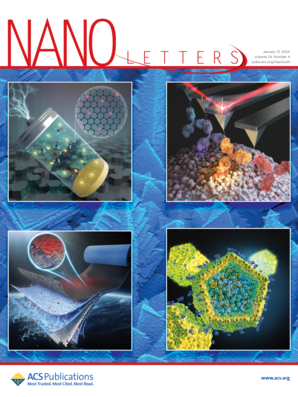Constructing a 5.2 V High-Voltage Electrolyte via TMSB Additive Enables Ultrahigh Rate Performance Graphite-Based Dual-Ion Batteries
IF 9.6
1区 材料科学
Q1 CHEMISTRY, MULTIDISCIPLINARY
引用次数: 0
Abstract
The development of carbon-based dual-ion batteries (DIBs) is essentially limited by the oxidation decomposition of the electrolyte at high voltage and the unsatisfactory stability of the cathode–electrolyte interface (CEI). Herein, to address these notorious issues, we successfully achieved a high-performance DIB by introducing the Tris(trimethylsiloxy)boron (TMSB) additive. It effectively regulated the solvation structure of the original 2 M LiPF6-solved EMC electrolyte. As a result, it not only weakens the coordination between the PF6– anion and EMC solvent but also suppresses EMC decomposition at the cathode interface. Such regulation facilitates the formation of a stable CEI layer enriched with highly ion-conductive inorganic components. Benefitting from the optimized interfacial kinetics, the graphite cathode delivers exceptional stability and rate capability, achieving 87.86% capacity retention after 2000 cycles at 5.2 V and 84.21% capacity retention at 50 C.

利用TMSB添加剂制备5.2 V高压电解液实现超高倍率性能石墨基双离子电池
碳基双离子电池(DIBs)的发展主要受到电解液在高压下的氧化分解和阴极-电解质界面(CEI)稳定性不理想的限制。在此,为了解决这些臭名昭著的问题,我们通过引入三甲基硅氧基硼(TMSB)添加剂成功地实现了高性能的DIB。它有效地调节了原来的2 M lipf6解决的EMC电解质的溶剂化结构。因此,它不仅削弱了PF6 -阴离子与EMC溶剂的配位,而且抑制了阴极界面的EMC分解。这种调控有利于形成富含高离子导电性无机组分的稳定CEI层。得益于优化的界面动力学,石墨阴极提供了卓越的稳定性和速率能力,在5.2 V下循环2000次后容量保持率达到87.86%,在50 C时容量保持率达到84.21%。
本文章由计算机程序翻译,如有差异,请以英文原文为准。
求助全文
约1分钟内获得全文
求助全文
来源期刊

Nano Letters
工程技术-材料科学:综合
CiteScore
16.80
自引率
2.80%
发文量
1182
审稿时长
1.4 months
期刊介绍:
Nano Letters serves as a dynamic platform for promptly disseminating original results in fundamental, applied, and emerging research across all facets of nanoscience and nanotechnology. A pivotal criterion for inclusion within Nano Letters is the convergence of at least two different areas or disciplines, ensuring a rich interdisciplinary scope. The journal is dedicated to fostering exploration in diverse areas, including:
- Experimental and theoretical findings on physical, chemical, and biological phenomena at the nanoscale
- Synthesis, characterization, and processing of organic, inorganic, polymer, and hybrid nanomaterials through physical, chemical, and biological methodologies
- Modeling and simulation of synthetic, assembly, and interaction processes
- Realization of integrated nanostructures and nano-engineered devices exhibiting advanced performance
- Applications of nanoscale materials in living and environmental systems
Nano Letters is committed to advancing and showcasing groundbreaking research that intersects various domains, fostering innovation and collaboration in the ever-evolving field of nanoscience and nanotechnology.
 求助内容:
求助内容: 应助结果提醒方式:
应助结果提醒方式:


